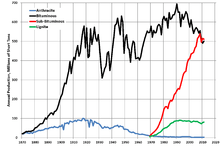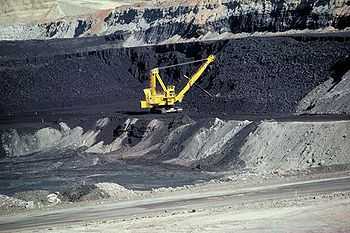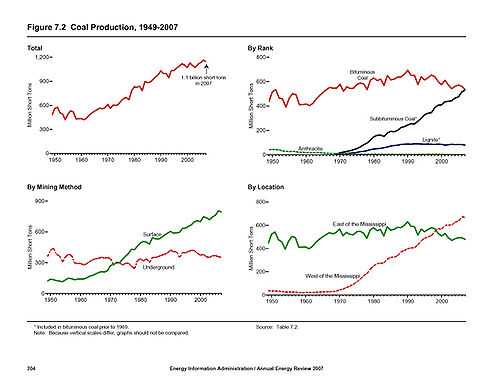History of coal mining in the United States




Anthracite (or "hard" coal) exploitation began before the War of 1812 spurred by the interest and opportunism of the Wurt brothers of Philadelphia. Burning clean and smokeless, anthracite became the preferred fuel in cities, replacing wood by about 1850, the same pattern seen in Europe. The East became deforested, driving up price of fuel wood. Anthracite from the Northeastern Pennsylvania Coal Region and later from West Virginia was valued for household use because it burns cleanly with little ash. It was also used in the early foundries of Philadelphia, New York, Newark and Allentown. The rich Pennsylvania anthracite fields were close to the big eastern cities, and nearly every major railroad in the Eastern United States such as the Reading Railroad, Lehigh & Erie, Central Railroad of New Jersey, Pennsylvania Railroad and Delaware and Hudson Railroad, extended lines into the anthracite fields. Many railroads began as mining company shortline railroads. By 1840, annual hard coal output had passed the million-short ton mark, and then quadrupled by 1850, and as it grew it pushed railroad construction, mining and steel production in a synergistic symbiosis.
Bituminous coal (or "soft coal") mining came later. In the mid-century Pittsburgh was the principal market. After 1850 soft coal, which is cheaper but dirtier, came into demand for railway locomotives and stationary steam engines, and was used to make coke for steel after 1870.[1]
Total coal output soared until 1918; before 1890, it doubled every ten years, going from 8.4 million short tons in 1850 to 40 million in 1870, 270 million in 1900, and peaking at 680 million short tons in 1918. New soft coal fields opened in Ohio, Indiana and Illinois, as well as West Virginia, Kentucky and Alabama. The Great Depression of the 1930s lowered the demand to 360 million short tons in 1932.[2]
Mining history by state
Pennsylvania
Pennsylvania began the coal industry in the United States when
At the beginning of the 1800s, the Lackawanna Valley in Pennsylvania was rich in anthracite coal and iron deposits. Brothers George W. Scranton and Seldon T. Scranton moved to the valley in 1840 and settled in the five-house town of Slocum's Hollow (now Scranton) to establish an iron forge.[3][4] Although Europeans had been making steel for nearly three centuries, the processes for creating blister steel and crucible steel were slow and extremely expensive. The Scrantons focused instead on manufacturing pig iron using a blast furnace.[3] The Scrantons wished to take advantage of a recent technological innovation in iron smelting, the "hot blast."[3] Developed in Scotland in 1828, the hot blast preheats air before it is pumped through molten iron, substantially lowering fuel needs.[3] The Scrantons also wished to experiment with using anthracite coal to make steel, rather than existing methods which used charcoal or bituminous coal.[5]
West Virginia
_crop.jpg)
In 1883, thousands of European immigrants and a large number of African Americans migrated to southern West Virginia to work in coal mines. These coal miners worked in company mines with company tools and equipment, which they were required to lease. Along with these expenses, the miners were deducted pay for housing rent and items they purchased from company stores. Furthermore, the coal companies went as far as creating their own monetary system so the miners could only shop at company owned stores.[6]
In addition to the poor economic condition, safety in the mines was a great concern. West Virginia fell behind other states in regulating mining conditions, and between 1890 and 1912, had a higher mine death rate than any other state. West Virginia was the site of the worst coal mining disaster to date, the Monongah Mining disaster of Monongah, West Virginia in 1907. The disaster was caused by the ignition of methane gas (also called "firedamp"), which in turn ignited the coal dust, killing 362 men. The disaster impelled the United States Congress to create the Bureau of Mines.[7]
United Mine Workers union
| Coal Producing States, 1889[8] | |
|---|---|
| State | Coal Production (thousands of short tons) |
| Pennsylvania | 81,719 |
| Illinois | 12,104 |
| Ohio | 9,977 |
| West Virginia | 6,232 |
| Iowa | 4,095 |
| Alabama | 3,573 |
| Indiana | 2,845 |
| Colorado | 2,544 |
| Kentucky | 2,400 |
| Kansas | 2,221 |
| Tennessee | 1,926 |
Since it was founded in 1890, the United Mine Workers (UMW) labor union has played a key role in United States coal mining. Strikes were very common, the rhetoric employed about exploitation was effective in mobilizing strikers. Detailed analysis of historical data by Fishback (1992) shows that mining wages were as high, if not higher, than those in manufacturing industry; that the prices in company stores were rarely higher than those in independent stores; and that miners who were dissatisfied with working conditions in a particular mining camp could either "vote with their feet" by migrating elsewhere or use the "voice" of collective union action to resist the threatened abuse.[9] Some notable labor strikes and events include:
- Bituminous Coal Miners' Strike of 1894
- Lattimer Massacre, 1897
- Battle of Virden, 1898
- Coal Strike of 1902
- Ludlow massacre, 1914
- Herrin Massacre, 1921
Under John L. Lewis, the United Mine Workers became the dominant force in the coal fields in the 1930s and 1940s, producing high wages and benefits.[10]
UMW membership among active miners fell from 160,000 in 1980 to only 16,000 in 2005, as coal mining became more mechanized and non-union miners predominated in the new coal fields in the western states.
Mechanization

Irish mining engineer Richard Sutcliffe invented the first conveyor belt for use in the coal mines of Yorkshire in the early 1900s. Within the first forty years of the 20th century, more than sixty percent of US coal was loaded mechanically rather than by man power. The history of the industry is the history of increasing mechanization.[11] As mechanization continued, fewer miners were needed, and some miners reacted with violence. One of the first machines to arrive at West Virginia’s Kanawha field had to be escorted by armed guards. The same machine introduced at a mine in Illinois was operated at a slow speed because the superintendent feared labor troubles.
Despite resistance, mechanization replaced more and more laborers. By 1940, over 2/3 of coal loaded in the large West Virginia fields was done by machine. With the increase of mechanization came much higher wages for those still employed, but hard times for the former miners because there were very few other jobs in or near the camps. Most moved to the cities to find work, or back to the hills where they started.

In 1914 at the peak there were 180,000 anthracite miners; by 1970 only 6,000 remained. At the same time steam engines were phased out in railways and factories, and bituminous was used primarily for the generation of electricity. Employment in bituminous peaked at 705,000 men in 1923, falling to 140,000 by 1970 and 70,000 in 2003.
During World War II, the Solid Fuels Administration for War operated government-seized coal mines, either directly or through cooperation with successive Coal Mines Administrations.[12]
In the 1960s a series of mergers saw coal production shift from small, independent coal companies to large, more diversified firms. Several oil companies and electricity producers acquired coal companies or leased Federal coal reserves in the west of the United States. Concerns that competition in the coal industry could decline as a result of these changes were heightened by a sharp rise in coal prices in the wake of the 1973 oil crisis. Coal prices fell in the 1980s, partly in response to oil price decline, but primarily in response to the large increase in supply worldwide which was brought about by the earlier price surge. During this period, the industry in the U.S. moved to low-sulfur coal.[13]
In 1987 Wyoming became the largest coal producing state. It uses strip mining exclusively. Wyoming's coal reserves total about 69.3 billion tons, or 14.2% of the U.S. coal reserve.[14]
In 2008, competition was intense in the US coal mining industry with some U.S. mines approaching the end of their useful life (mine closure). Other coal-producing countries also stepped up production to win a share of traditional US export markets. Coal is used primarily to generate electricity, but the rapid drop in natural gas prices after 2010 created severe competition.
See also
- Coal mining in Colorado
- Coal mining in the United States
- Coal Region of Pennsylvania
- Harrisburg Coal Field of Illinois
- History of coal mining
Bibliography
Industry
- Sean Patrick Adams, . "The US Coal Industry in the Nineteenth Century." EH.Net Encyclopedia, August 15, 2001 scholarly overview
- Sean Patrick Adams, Old Dominion, Industrial Commonwealth: Coal, Politics, and Economy in Antebellum America. Johns Hopkins University Press, 2004.
- Chandler, Alfred. "Anthracite Coal and the Beginnings of the ‘Industrial Revolution' in the United States", Business History Review 46 (1972): 141-181. in JSTOR
- DiCiccio, Carmen.Coal and Coke in Pennsylvania. Harrisburg: Pennsylvania Historical and Museum Commission, 1996
- Conley, Phil. History of West Virginia Coal Industry (Charleston: Education Foundation, 1960)
- Eavenson, Howard. The First Century and a Quarter of the American Coal Industry (1942).
- Flores, Verla R., and A. Dudley Gardner. Forgotten Frontier: A History of Wyoming Coal Mining (1989) online edition
- Fred J. Lauver, "A Walk Through the Rise and Fall of Anthracite Might", Pennsylvania Heritage Magazine 27#1 (2001) online edition
- Long, Priscilla. Where the Sun Never Shines: A History of America's Bloody Coal Industry Paragon, 1989.
- Robert H. Nelson. The Making of Federal Coal Policy (1983)
- Parker, Glen Lawhon. The Coal Industry: A Study in Social Control (1940)
- Powell, H. Benjamin. Philadelphia's First Fuel Crisis. Jacob Cist and the Developing Market for Pennsylvania Anthracite. The Pennsylvania State University Press, 1978.
- Rottenberg, Dan. In the Kingdom of Coal: An American Family and the Rock That Changed the World (2003)], owners' perspective online edition
- Schurr, Sam H., and Bruce C. Netschert. Energy in the American Economy, 1850-1975: An Economic Study of Its History and Prospects. (1960).
- United States Anthracite Coal Strike Commission, 1902-1903, Report to the President on the Anthracite Coal Strike of May–October, 1902 By United States Anthracite Coal Strike (1903) online edition
- Vietor, Richard H. K. and Martin V. Melosi; Environmental Politics and the Coal Coalition Texas A&M University Press, 1980 online
- Warren, Kenneth. Triumphant Capitalism: Henry Clay Frick and the Industrial Transformation of America. (1996).
Miners and unions
- Aurand, Harold W. Coalcracker Culture: Work and Values in Pennsylvania Anthracite, 1835-1935 2003
- Blatz, Perry. Democratic Miners: Work and Labor Relations in the Anthracite Coal Industry, 1875-1925. (1994).
- Corbin, David Alan.Life, Work, and Rebellion in the Coal Fields: The Southern West Virginia Miners, 1880-1922 (1981)
- Coal Mines Administration, U.S, Department Of The Interior. A Medical Survey of the Bituminous-Coal Industry. U.S. Government Printing Office. 1947. online
- Eller, Ronald D. Miners, Millhands, and Mountaineers: Industrialization of the Appalachian South, 1880–1930 (1982)
- Fox, Mayor. United We Stand: The United Mine Workers of America 1890-1990 (UMW 1990), detailed semiofficial union history.
- Grossman, Jonathan. "The Coal Strike of 1902 – Turning Point in U.S. Policy" Monthly Labor Review October 1975. online
- Harvey, Katherine. The Best Dressed Miners: Life and Labor in the Maryland Coal Region, 1835-1910. Cornell University Press, 1993.
- Lantz; Herman R. People of Coal Town Columbia University Press, 1958; on southern Illinois; online
- Lewis, Ronald L. Black Coal Miners in America: Race, Class, and Community Conflict. University Press of Kentucky, 1987.
- Lunt, Richard D. Law and Order vs. the Miners: West Virginia, 1907-1933 Archon Books, 1979, On labor conflicts of the early twentieth century.
- Phelan, Craig. Divided Loyalties: The Public and Private Life of Labor Leader John Mitchell (1994)
- Rössel, Jörg. Industrial Structure, Union Strategy and Strike Activity in Bituminous Coal Mining, 1881 - 1894 Social Science History 26 (2002): 1 - 32.
- Roy, Andrew. A History Of The Coal Miners Of The United States, From The Development Of The Mines To The Close Of The Anthracite Strike Of 1902 (1907) online full text
- Trotter Jr., Joe William. Coal, Class, and Color: Blacks in Southern West Virginia, 1915-32 (1990)
- U.S. Immigration Commission, Report on Immigrants in Industries, Part I: Bituminous Coal Mining, 2 vols. Senate Document no. 633, 61st Cong., 2nd sess. (1911)
- Wallace, Anthony F.C. St. Clair. A Nineteenth-Century Coal Town's Experience with a Disaster-Prone Industry. (1981)
- Ward, Robert D., and William W. Rogers, Labor Revolt in Alabama: The Great Strike of 1894 1965 online coal strike
References
- ↑
- Frederick Moore Binder, Coal Age Empire: Pennsylvania Coal and Its Utilization to 1860. Harrisburg: Pennsylvania Historical and Museum Commission, 1974.
- ↑ Bruce C. Netschert and Sam H. Schurr, Energy in the American Economy, 1850-1975: An Economic Study of Its History and Prospects. pp 60-62.
- ↑ 3.0 3.1 3.2 3.3 Yeomans, "36 Hours: Scranton, Pa.," New York Times, November 1, 2002.
- ↑ "The Bitter Battle," Time, October 19, 1962.
- ↑ Lewis, "The Early History of the Lackawanna Iron and Coal Company: A Study in Technological Adaptation," Pennsylvania Magazine of History and Biography, October 1972.
- ↑ "West Virginia Division of Culture and History"
- ↑ "United States Mine Rescue Association"
- ↑ Source: Thirteenth Census of the United States, Vol. XI, Mines and Quarries, 1913, Table 4, p. 187
- ↑ Price V. Fishback, Soft Coal, Hard Choices: The Economic Welfare of Bituminous Coal Miners, 1890-1930 (1992)
- ↑ Dubofsky and Van Tine (1977)
- ↑ Keith Dix, What's a Coal Miner to Do? The Mechanization of Coal Mining (1988)
- ↑ "Records of the Solid Fuels Administration for War [SFAW]". National Archives: Guide to Federal Records. Retrieved 2013-09-01.
- ↑ "Coal Mining Industry Report" IBISWorld, 2009
- ↑ Manuel Lujan; Harry M. Snyder (1992). Surface Coal Mining Reclamation: 15 Years of Progress, 1977-1992, Statistical Information. DIANE. p. 68.
![]() This article incorporates public domain material from the National Archives and Records Administration document "Records of the Solid Fuels Administration for War (SFAW)".
This article incorporates public domain material from the National Archives and Records Administration document "Records of the Solid Fuels Administration for War (SFAW)".
External links
- "Reflections" Mining History, a short 2002 documentary on the history of American coal mining and mine safety, produced by the United States Mine Safety and Health Administration.
- West Virginia coal mining history
| ||||||||||||||
| ||||||||
